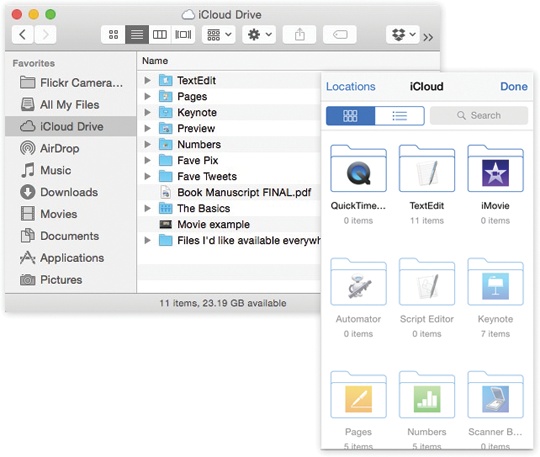Truth is, “cloud” is an annoying buzzword. Most of the time, when people say “in the cloud,” they mean “on the Internet”—a term that has served us perfectly well for years.
In any case, you can save your files online, into an online “hard drive” called iCloud Drive—Apple’s version of the OneDrive (SkyDrive) in Windows. It makes your files available for opening or editing from any computer or gadget you use, including iPhones, iPads, and iPod Touches.
iCloud Drive is like a magic folder. In the Finder, it’s represented by an iCloud Drive icon in the Sidebar of every window.
Whatever you put into it appears, almost instantly, in the iCloud Drive folder on all your other machines: Macs, iPhones, iPads, and even Windows PCs. In fact, your files will even be available at iCloud.com, so you can grab them even when you’re stranded on a desert island with nothing but somebody else’s computer. (If this concept reminds you of the popular free program Dropbox, then you’re very wise.) Figure 4-32 shows the idea.
Figure 4-32. Left: The iCloud Drive icon appears in the Sidebar of every Finder window and Save/Open dialog box. Right: It also appears on every iPhone, iPad, or iPod Touch you have. (Assuming they’re running iOS 8 or later, and are signed into the same iCloud account.)
This is an incredibly useful feature. No more emailing files to yourself. No more carrying things around on a flash drive. After working on some document at the office, you can go home and resume from right where you stopped; the same file is waiting for you, exactly as you left it.
iCloud Drive also makes a gloriously simple, effective backup disk. Anything you drag into this “folder” is instantly copied to all your devices and computers. And, as you know, the more copies that exist of something (and in the more locations), the better your backup. Even if your main Mac is stolen or burned to aluminum dust, your iCloud Drive files are safe.
Your drive holds 5 gigabytes of files for free. You can pay extra for more space: $1 a month for 20 gigs, $4 a month for 200 gigs, $10 for 500 gigs, or $20 a month for one terabyte (1,000 gigabytes).
On the Mac, you use the iCloud Drive just as you would a folder or a flash drive. Click its name in the Sidebar to see what’s in there. Drag files into its window to copy them there. Make folders, add files, delete files, rename them—whatever. Any changes you make are reflected on your other Apple (and Windows) gadgets within seconds.
Inside a program, you can choose File→Save in the usual way. When the Save box appears, click iCloud Drive in the Sidebar. Or choose an iCloud Drive folder’s name, if you’ve made one.
Tip
The window shown in Figure 4-32 shows your iCloud Drive documents and lets you open them, even when you’re offline. How? Turns out your Mac stores a secret “local” copy. The changes you make won’t update the online copy until you’re online again, but at least you’re never cut off from your own files.
So: If the iCloud Drive behaves just like a folder on your Mac, how does it appear on iPhones, iPads, and Windows computers? Like this:
On the iPhone, iPad, or iPod Touch. The iCloud Drive is a feature of iOS 8 or later, but there’s no app sitting there called iCloud Drive.
Instead, you have to open an iCloud Drive–compatible app. Most of Apple’s apps are iCloud-compatible (Pages, Numbers, Keynote, and so on), and software companies can update their apps to recognize iCloud Drive, too.
Once you’re in an iCloud-aware program, use the Open command—the first time an Open dialog box has ever been built into the iPhone. There, arrayed before you, are all the folders of your iCloud Drive. Any document you save here will, of course, automatically show up in the iCloud Drive folders of all your other machines.
On a Windows PC. Your computer needs Windows 7 or later, and it requires the iCloud control panel. (You can download it from this book’s “Missing CD” at www.missingmanuals.com.) It does just what you’d expect: It creates an iCloud Drive icon in your File Explorer windows, exactly as on the Mac.
Get Switching to the Mac: The Missing Manual, Yosemite Edition now with the O’Reilly learning platform.
O’Reilly members experience books, live events, courses curated by job role, and more from O’Reilly and nearly 200 top publishers.


